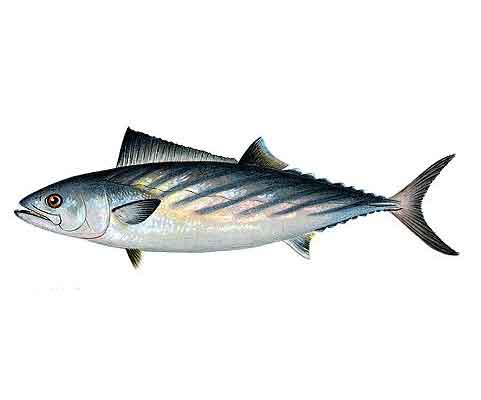
Sarda sarda (*)
Superregnum: Eukaryota
Cladus: Unikonta
Cladus: Opisthokonta
Cladus: Holozoa
Regnum: Animalia
Subregnum: Eumetazoa
Cladus: Bilateria
Cladus: Nephrozoa
Superphylum: Deuterostomia
Phylum: Chordata
Subphylum: Vertebrata
Infraphylum: Gnathostomata
Megaclassis: Osteichthyes
Superclassis/Classis: Actinopterygii
Classis/Subclassis: Actinopteri
Subclassis/Infraclassis: Neopterygii
Infraclassis: Teleostei
Megacohors: Osteoglossocephalai
Supercohors: Clupeocephala
Cohors: Euteleosteomorpha
Subcohors: Neoteleostei
Infracohors: Eurypterygia
Sectio: Ctenosquamata
Subsectio: Acanthomorphata
Divisio/Superordo: Acanthopterygii
Subdivisio: Percomorphaceae
Series: Pelagiaria
Ordo: Scombriformes
Familia: Scombridae
Subfamilia: Scombrinae
Genus: Sarda
Species: S. sarda
Name
Sarda sarda (Bloch, 1793)
Vernacular names
Afrikaans: Atlantiese bonito
català: Bonítol
Ελληνικά: Παλαμίδα
English: Atlantic Bonito
italiano: Palamita
lietuvių: Pelamidė
polski: Pelamida
svenska: Atlantisk bonito
The Atlantic bonito (Sarda sarda) is a large mackerel-like fish of the family Scombridae. It is common in shallow waters of the Atlantic Ocean, the Mediterranean Sea, and the Black Sea, where it is an important commercial and game fish.
Description
Atlantic bonito belong to a group which have the dorsal fins very near, or separated by a narrow interspace. Its body is completely scaled, with those scales in the pectoral fin area and the lateral line usually larger in size. Bonitos (fishes in the genus Sarda) differ from tuna by their compressed bodies, their lack of teeth on the roof of the mouth, and certain differences in colouration.
Atlantic bonito share Atlantic waters with the striped bonito, Sarda orientalis (the Atlantic population of which is sometimes considered a separate species, Sarda velox). The striped bonito has been taken on the Atlantic coast as far north as Cape Cod. It is similar in its habits, but somewhat smaller than the more common Atlantic bonito. The Atlantic bonito can be distinguished from its relative by its dark oblique stripes on the back and with a maxillary only about half as long as the head, whereas the striped bonito has striping on its topside nearly horizontal and a maxillary more than half the length of the head.
Atlantic bonito grow up to 75 centimetres (30 in) and weigh 5–6 kilograms (11–13 lb) at this size. The world record, 18 pounds 4 ounces (8.3 kg), was caught in the Azores.[4]
Habits
It is a strong swimmer. Normally, it travels in fairly large schools and is common offshore in the vicinity of New York City, where it is known as "skipjack" because of its habit of jumping from the water. (However, the name "skipjack" more commonly refers to the skipjack tuna, Katsuwonus pelamis.) The spawning season is June, and specimens 12–15 centimetres (4.7–5.9 in) long are taken in September off Long Island.
Diet
Atlantic bonito eat mackerel, menhaden, alewives, silversides, sand lances, and other fishes, as well as squid.
Fishing technique
Bonito are often captured by tuna fishermen when trolling for bigger game. Bonito have also been caught using pound nets, and amongst other species as bycatch during the traditional fishing practice of Almadraba in addition to the main catch, the far larger Atlantic bluefin tuna. Thought by most fishermen to be inferior to tuna as a food fish, possibly because of the greater oiliness, it is sometimes used as bait.
As food
Bonito is a popular food fish in the Mediterranean; its flesh is similar to tuna and mackerel, and its size is intermediate between the two.[5]
Bonito under 1 kg (2.2 lb) or so (called palamut ~ паламуд in Bulgarian) are often grilled as steaks. Larger bonito (torik in Turkish) are cut into steaks and preserved as lakerda.[5] Bonito is also canned, but canned bonito del norte (Spanish) is not bonito, but albacore tuna.
In Algeria and Spain, it is often prepared as escabeche, which preserves it for about a week.[5] Bonito may also be baked and served cold.[6]
References
Collette, B.; Amorim, A.; Boustany, A.; Carpenter, K.; Dooley, J.; Fox, W.; Fredou, F.; Fritzsche, R.; Graves, J.; Hazin, F.; Herdson, D.; Juan Jorda, M.J.; Leite, N.; Lessa, R.; Matsuura, K.; Minte-Vera, C.; Nelson, J.; Nelson, R.; Oxenford, H.; Travassos, P. (2011). "Sarda sarda". IUCN Red List of Threatened Species. 2011: e.T155096A4703085. doi:10.2305/IUCN.UK.2011-2.RLTS.T155096A4703085.en. Retrieved 19 November 2021.
"Sarda sarda". Integrated Taxonomic Information System. Retrieved 26 May 2016.
Froese, Rainer; Pauly, Daniel (eds.) (2018). "Sarda sarda" in FishBase. February 2018 version.
Brant, Ken (2005-05-02). "Atlantic Bonito". ESPN. Retrieved 2008-10-02.
Alan Davidson, Mediterranean Seafood, Penguin, 1972. ISBN 0-14-046174-4, p. 123
"Palamut papaz yahnisi", Davidson, p. 359
E. C. Raney "Atlantic Bonito." The Wise Fishermen's Encyclopedia (1951).
https://web.archive.org/web/20081226061817/http://www.landbigfish.com/fish/fish.cfm?ID=83
Hansen, Jorge Enrique (1986). Aspectos biológicos y pesqueros del bonito del Mar Argentino (Pisces: scombridae: sarda sarda) (Tesis). Universidad Nacional de La Plata. p. 104. Retrieved 22 April 2014.
Retrieved from "http://en.wikipedia.org/"
All text is available under the terms of the GNU Free Documentation License

